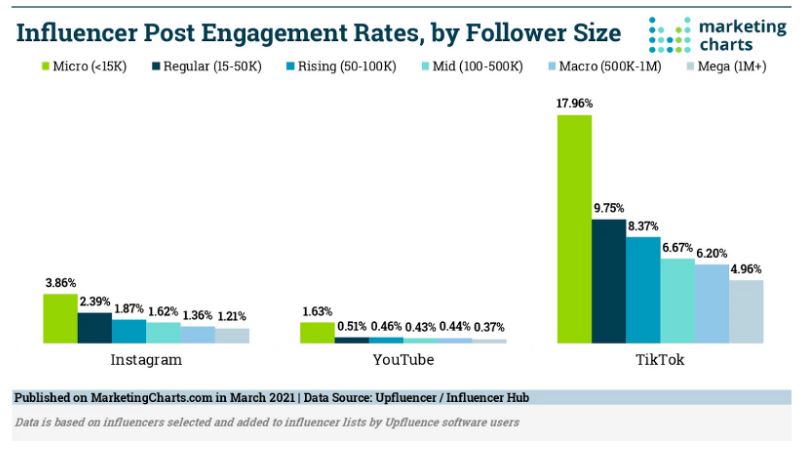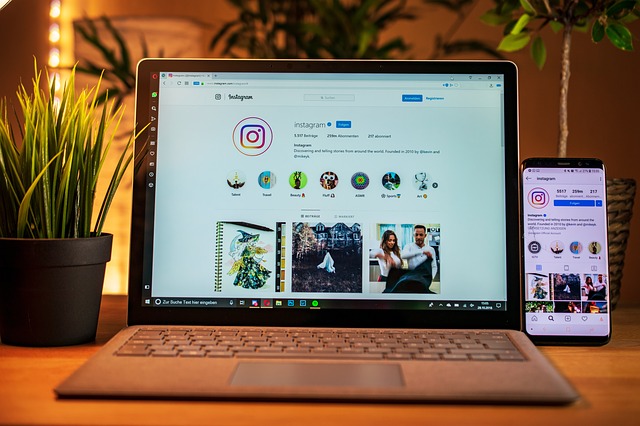5 Business Benefits of Working With Micro-influencers And Promoting Your Business
in Marketing by Sam O’Brien

With the global eCommerce market reaching $4.28 trillion in 2020 and expected to top $5.4 trillion in 2022, ensuring your online business has the widest reach possible has never been more important. Businesses are always searching for better ways to promote their business and find new customers.
You want your online store to be successful, and to be successful, you need significant traffic visiting your site and a healthy mix of loyal customers and new customers. To achieve that, you need a mix of strategies that best suit your particular business type and model.
One type of strategy that is seeing increased use is influencer marketing. This area has more than doubled in recent years, reaching $13.8 billion in 2021. People who follow influencers can base many buying decisions on what those people say, and the impact of influencers should never be underestimated.
Many businesses nowadays particularly focus on micro-influencers rather than macro-influencers, but what is the difference between the two, why should you choose micro-influencers, and what are the potential benefits of including them in your marketing strategy?
Micro-Influencers vs. Macro-Influencers
The primary difference between micro-influencers and macro-influencers lies in the number of followers each group has. Micro-influencers tend to have between 10,000 and 50,000 followers, while macro-influencers have anywhere from 500,000 to 1 million followers. So, surely macro-influencers are a better option? As with other things in life, size does not always matter.
Macro-influencers see more competition for their “services,” which means you could lose an element of uniqueness when they are representing multiple brands. Of course, macro-influencers will also tend to come at a higher price than micro-influencers as more brands are competing for their service.
It may be the case that you feel you need to work with more than one micro-influencer to achieve the goals you have set in relation to expanding your reach. What you need to consider is how many followers are shared between your micro-influencers, especially if you are operating in a niche market.
5 Business Benefits of Working with Micro-Influencers

1. Quality Beats Quantity
While it may be tempting to only look at the potential numbers macro-influencers offer, this is a case where quality can definitely be better than quantity. Micro-influencers will more often have a narrower focus and even niche appeal in some cases. They also tend to work with fewer brands than their larger counterparts, meaning they will likely put more effort into marketing your brand.
A micro-influencer will show more loyalty when they are part of your strategy as they will have fewer partners and are more likely to be a positive social media ambassador as you have put your trust (and investment) in them rather than others. They are more likely to be closely aligned with your brand as a whole and will offer a better ROI than influencers serving multiple brands.
Micro-influencers have closer relationships with their followers and usually produce more focused content that does not wander between multiple product types in most cases. This means that their work offers a better quality of service to you as a brand and is more likely to produce positive results.
2. A Better Match
A macro-influencer may cover one category, such as fashion, but they are unlikely to focus on a small number of subcategories. It is easier to find a micro-influencer who is a good match for your brand as they will focus more on those subcategories to establish their authority and influence. Their interest in your brand, and your products, is more likely to be genuine and can lead to an honest and symbiotic relationship.
If you choose your micro-influencers wisely, there is also likely to be a shared demographic. The people who follow your chosen influencer will probably represent a part, perhaps a significant part, of your demographic targets. When this is the case, it makes it easier for them to promote engagement with your brand to their followers.
This can be especially useful if you are in a niche market. Finding an influencer that fits well with the products and services you offer can lead to a win-win situation for all involved, including the consumers who follow that influencer and who you want as customers. Finding them in the first place will be easier, too, when they’re already present within your own niche. It’s not as easy as just typing “ambassador social media” into Google, but simpler nonetheless.
3. Better Engagement

The larger an audience is, the more difficult it can be to communicate with them. You already look at this issue by segmenting your customer base into different groups according to various relevant factors. Micro-influencers tend to be more engaged with their community than their larger counterparts, and this is something that works in your favor from day one.
Having an engaged audience that can ask questions and write comments to your micro-influencer means that your brand can get better exposure. Compared to macro-influencers, micro-influencers consistently have higher engagement rates across the main platforms used, including TikTok, YouTube, and Instagram.
This higher engagement rate most likely comes from the closer relationship micro-influencers have with their followers. They know their chosen sector well and, perhaps more importantly, they know what their followers like and want to read about. You can thus rely on them to produce engaging content that will efficiently promote your brand.
4. Lower Costs
With any sort of influencer marketing, remuneration models can vary greatly. They can include commission-based models or even be based on free products or services. Many influencers, however, will work on a pay-per-post model, with micro-influencers charging anything from $100-$500 per post compared to the $5000+ you will see charged by macro-influencers.
Those sorts of costs may vary according to how many channels an influencer utilizes, but you will always consider the channels they publish on as well as how big their reach is. In the early days of any relationship with a micro-influencer, it may be worth discussing a sliding scale that increases according to results and may even, in those initial stages at least, include a degree of you offering quid-pro-quo exposure, access to new products, and free products too.
Given the higher engagement rates they offer, coupled with the (often far) lower costs, this means that micro-influencers represent an opportunity for a higher ROI than the macro version. Of course, as with other types of performance marketing, you should monitor the effectiveness of any influencers over time to ensure that they are delivering a good ROI for your brand.
5. Trust and Genuineness

Just as you want to establish trust and authority as a brand when people search for your business, the same factors matter to micro-influencers. In recent years, many people have become skeptical of many influencers, especially those who are classed as celebrities. This group will often do things purely for financial gain, and growing public awareness of this means people have less confidence in some macro-influencers.
Micro-influencers usually come across as more genuine, and this helps establish a relationship built on trust with their followers. By extension, that trust can also be built in your brand if a particular influencer is genuinely promoting you. That can be particularly true when the influencer connects well with followers and comes across as both friendly and honest.
While most interactions occur online, some micro-influencers will attend promotional events, for example, when your business organizes an event to launch a new product. A good micro-influencer will try and respond to as many comments and questions as possible, though of course, this can become increasingly difficult as their followers grow in number.
The Takeaway

If you look at any performance marketing definition, you will find that influencer marketing can play a major role. That covers not only an increase in sales and revenue but also in expanding your brand’s awareness across multiple social media channels. By identifying a micro-influencer that fits well with your brand and the products you sell, you can reap real benefits.
One caveat is that if you are going to work with any level of influencer, you have to be aware that there are FTC regulations that apply to both you and the influencer themselves. Ensuring you work within those regulations means that there is transparency, which is something else that can contribute to establishing a relationship of trust with consumers.
It may take time to establish how effective any micro-influencers are. This is especially true with new influencer relationships, where it may take time for them to communicate how good your brand is for their followers. Monitor on an ongoing basis, ideally monthly, to see how they work as an ambassador for your brand.




